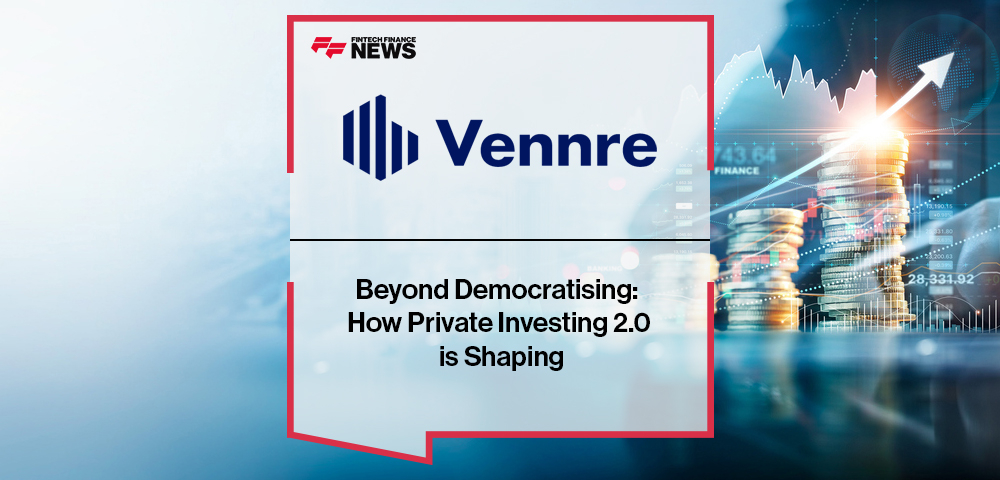Breaking News

Beyond Democratising: How Private Investing 2.0 is Shaping
By Ziad Mabsout, Co-Founder & CEO, Vennre
Individual investors account for just 5 – 10% of private market investments, with institutional players comprising the overwhelming majority. It’s a striking disconnect, and one that’s inspiring quite a debate in personal finance. A new generation of investors, particularly those in the HENRY category (High Earning, Not Rich Yet), are starting to question the conventional wisdom that has long kept them locked into public stocks and bonds.
And it’s hard to blame them.
The HENRY category is educated, digitally savvy, and earning upwards of six figures. But despite their progress on the salary ladder, many feel stuck and frustrated that traditional investment options seem increasingly inadequate in helping them achieve their financial goals.
Inflation is eating away at cash bonds. Public stock markets have grown volatile and unpredictable. And the most exciting, innovative companies are staying private for longer than ever before, capturing their biggest growth years behind closed doors.
According to Morningstar, the median age for companies going public has climbed to 10.7 years, more than double what it was in the 1990’s. Meanwhile, McKinsey reports that private markets have swelled to $14.3 trillion globally, growing sevenfold since 2009.
It’s clear that the private market is where real wealth is being created and making the rich richer, while HENRY’s and other demographics are being locked out.
Why Private Markets Are Essential to Modern Wealth
Private investments are no longer just a niche asset class for pension funds and endowments. They’ve become a critical part of modern portfolio strategy.
In the US, private equity has delivered annualised returns of about 15.2% over the last 10 years compared to 9.6% for public equities. High-net-worth portfolios now allocate roughly 20% to private markets on average.
Why the shift? Beyond higher returns, private assets offer diversification advantages that public markets can’t match. Venture capital, private credit, infrastructure and private equity open up exposures to real economic growth in sectors that are invisible on public exchanges.
For HENRYs, who are still in the wealth-building phase, this combination of long-term growth and diversification is exactly what their portfolios need.
How We Got Here & Breaking Down the Barriers
Historically, private markets were designed to exclude most individual investors. Minimum investments ran into the millions. Regulations restricted participation to those with high net worth or institutional status. And the processes were opaque, slow, and paper-based.
But thankfully, change is finally happening.
In the past few years, governments and regulators around the world have begun lowering the barriers to entry for retail investors. In the UK, the Financial Conduct Authority (FCA) has designated Long-Term Asset Funds (LTAFs) as suitable for the mass market. In the EU, the European Long-Term Investment Fund (ELTIF) has been overhauled to scrap the €10,000 minimum investment requirement. And Singapore’s Monetary Authority is introducing a Long-term Investment Fund (LIF) specifically designed for retail investors.
These changes mean more investors can participate, at lower minimums, with clearer disclosures and protections. But access is just the first step.
Technology Levels the Playing Field
Even with regulatory reform, private markets have a reputation for being complex and intimidating. For many individual investors, knowing where to start or how to construct a sensible portfolio can feel overwhelming.
That’s where technology, and increasingly artificial intelligence, is elevating the whole experience. Digital onboarding, automated risk profiling, interactive simulations, and fractional investments allow individuals to access funds at much lower thresholds.
AI is helping investors go further by modelling different scenarios, evaluating suitability, and providing personalised coaching. The result is a smarter and more empowering investor experience by balancing automation with advice.
Building the Overlooked Private Layers
Private markets are often the overlooked layer of a well-constructed portfolio, a foundational piece that, until recently, has been out of reach for HENRYs and the next generation of investors. Increasingly, we’re seeing platforms emerge that are designed specifically for this audience, combining intelligent automation with advisory-led tools to support access to private investments in a way that aligns with broader financial goals.
This innovation is about enabling the development of smarter, more resilient portfolios that reflect where wealth is actually being created in today’s economy. Many of these platforms are also exploring ways to integrate savings and liquidity tools, moving towards a more holistic, advisory-driven experience that evolves as the user’s needs change.
At its core, this is bigger than just access. It’s about building confidence, helping investors understand risk, and giving people more control over how they grow and protect their wealth.
What Comes Next
We’re at the early stages of the private investment for individuals, and really, the transformation is yet to come. Tokenisation of private market funds is gaining traction fast. Over half of institutional investors now expect private equity to be tokenised within the next 2-3 years, opening up liquidity, tradability and access at scale which we haven’t seen before. It’s clear the appetite is there, since 92% of portfolio advisors already include alternatives in portfolios, and almost all plan to grow those allocations.
The next chapter will be written by those who balance ambition with responsibility. If we get it right, private markets could become as mainstream as public equities, which is the core building block for wealth creation among the next generation of investors. But that will only happen if access comes with the same education, transparency and safeguards that institutions have enjoyed for decades.
The Wealth Opportunity of a Generation
Private markets are no longer an exclusive club. They shouldn’t be treated like one. With the right mix of technology, regulatory progress, and thoughtful advisory, private markets can, and should, be part of the future of personal finance.
This shift is already happening, and we’re extremely passionate about our mission at Vennre, where we’re making these inroads a reality for the next generation of investors. It isn’t just about catching up to the ultra-wealthy. It’s about creating a fairer and smarter system for everyone, and making sure no one is left behind.
People In This Post
Companies In This Post
- EXCLUSIVE: “Stable & Secure?” – Simone Loefgen, Commerzbank in ‘Discover Sibos 2025’ Read more
- CBI Drives Verification of Payee Compliance in Italy Read more
- Lastro Secures $15M Series A Led by Prosus Ventures to Scale its AI Agent, Empowering Over 2M Homebuyers Read more
- Evertec Announces Closing of Controlling Stake in Tecnobank, Expanding Product Offering in Brazil Read more
- EXCLUSIVE: “Scaling Safely – Without Debanking” – Imam Saygili, Flagright in ‘The Fintech Magazine’ Read more
















